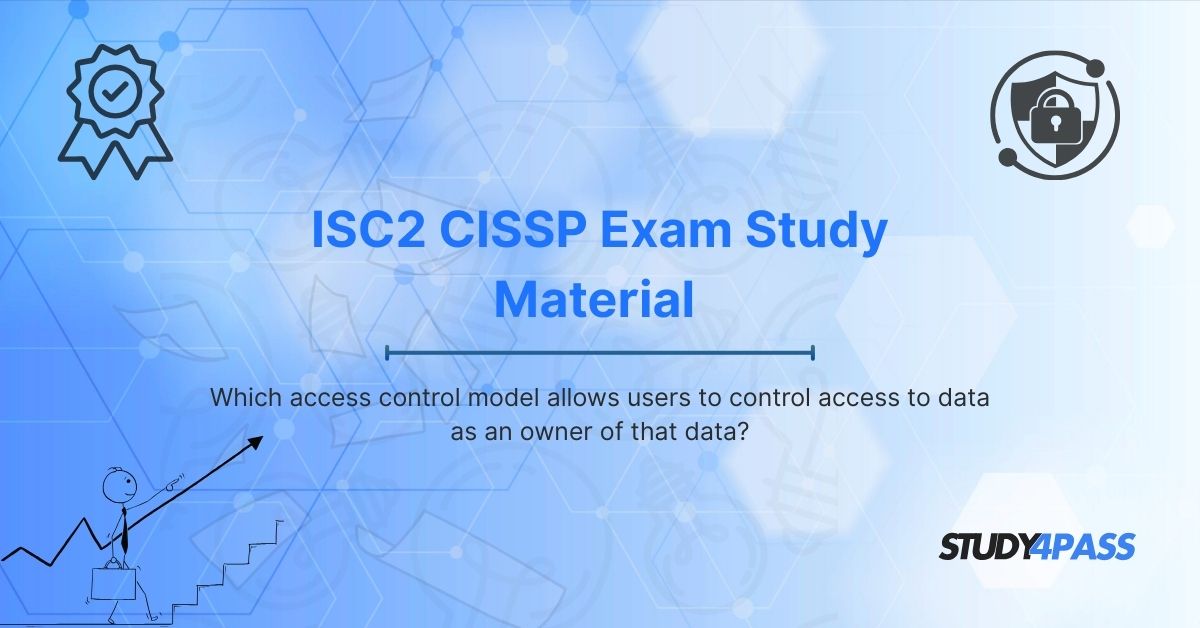Introduction
Access control is a fundamental concept in information security, ensuring that only authorized users can access specific resources. Among various access control models, Discretionary Access Control (DAC) stands out because it allows data owners to control access to their data. This model is a key topic in the Certified Information Systems Security Professional (CISSP) exam, a prestigious credential offered by (ISC)².
This article explores:
- The DAC model and how it works
- Comparison with other access control models
- Relevance in CISSP certification
- How Study4Pass helps CISSP aspirants master these concepts
By the end, you’ll have a comprehensive understanding of DAC and its role in cybersecurity.
What is Discretionary Access Control (DAC)?
Discretionary Access Control (DAC) is a security model where the owner of the data determines who can access it. Unlike mandatory models, DAC is flexible, allowing users to modify permissions based on their discretion.
Key Characteristics of DAC:
- Data Ownership: The creator or owner of a file has full control over its permissions.
- Access Control Lists (ACLs): Permissions are managed through ACLs, specifying which users/groups can read, write, or execute files.
- User-Centric: Users can grant or revoke access without administrative intervention.
- Common in Operating Systems: Windows (NTFS permissions) and Linux (file permissions) use DAC.
Example of DAC in Action:
- A project manager creates a confidential report.
- Using DAC, they grant read-only access to team members but full edit rights to senior management.
- If a team member leaves, the manager can revoke access instantly.
Comparison with Other Access Control Models
To understand DAC’s significance, we must compare it with other models:
|
Model |
Control Mechanism |
Flexibility |
Use Case |
|
DAC (Discretionary) |
Owner-controlled |
High |
File-sharing, personal data |
|
MAC (Mandatory) |
System-enforced (labels) |
Low |
Military, government |
|
RBAC (Role-Based) |
Role-based permissions |
Medium |
Enterprises, organizations |
|
ABAC (Attribute-Based) |
Dynamic rules (attributes) |
High |
Cloud, IoT |
Why DAC is Unique?
- User Empowerment: Unlike MAC (where admins enforce rules), DAC lets users decide.
- Ease of Use: Simpler to implement in small-scale environments.
- Risk Factor: Can lead to security risks if users mishandle permissions.
DAC in the CISSP Exam – (ISC)² Perspective
The CISSP certification by (ISC)² covers DAC as part of Domain 5: Identity and Access Management (IAM).
Key CISSP Exam Points on DAC:
- Ownership Principle: Understand how data owners assign permissions.
- Security Risks: Over-permission can lead to insider threats.
- Comparison with MAC/RBAC: Know when to use each model.
- Real-world Applications: How enterprises implement DAC.
Advantages and Disadvantages of DAC
Pros:
- Flexibility: Users can adjust permissions as needed.
- User-Friendly: Easy to implement in small teams.
- Quick Adjustments: No need for admin approval for access changes.
Cons:
- Security Risks: Users may grant excessive permissions.
- Lack of Central Control: Difficult to enforce uniform policies.
- Prone to Errors: Inexperienced users may misconfigure ACLs.
Study4Pass: Your Ultimate CISSP Study Companion
Preparing for the CISSP exam requires structured learning and reliable resources. Study4Pass offers:
Why Choose Study4Pass for CISSP?
- Comprehensive Study Guides: Covers all 8 CISSP domains, including Access Control Models.
- Practice Exams: Simulates real (ISC)² test questions with detailed explanations.
- Expert-Led Training: Learn from certified CISSP professionals.
- Updated Content: Aligned with the latest (ISC)² exam syllabus.
- Flexible Learning: Study at your own pace with video tutorials & flashcards.
How Study4Pass Helps You Master DAC & Other Models?
- Interactive Quizzes: Test your knowledge on DAC vs MAC vs RBAC.
- Case Studies: Real-world examples of access control implementations.
- Exam Tips: Strategies to tackle CISSP scenario-based questions.
"With Study4Pass, I aced my CISSP exam on the first attempt! Their DAC explanations were crystal clear."
Conclusion
The Discretionary Access Control (DAC) model is a user-centric approach where data owners control access permissions. While it offers flexibility, it also poses security risks if misused.
For CISSP aspirants, understanding DAC is crucial as it’s a key topic in (ISC)²’s certification exam. Leveraging resources like Study4Pass ensures you grasp these concepts effectively and pass the exam with confidence.
Final Thoughts:
- DAC = User-controlled permissions.
- CISSP heavily tests access control models.
- Study4Pass provides the best CISSP preparation tools.
Start your CISSP journey today with Study4Pass and become an (ISC)² certified professional!
Special Discount: Offer Valid For Limited Time “CISSP Study Material”
Actual Exam Questions For ISC2's CISSP Training
Sample Questions For ISC2 CISSP Exam Study Guide
1. Which access control model allows users to control access to their own data as owners?
A) Mandatory Access Control (MAC)
B) Discretionary Access Control (DAC)
C) Role-Based Access Control (RBAC)
D) Rule-Based Access Control (RBAC)
2. In which access control model does the data owner decide who has permissions?
A) Role-Based Access Control (RBAC)
B) Mandatory Access Control (MAC)
C) Discretionary Access Control (DAC)
D) Attribute-Based Access Control (ABAC)
3. Which of the following access control models is user-centric, allowing data owners to grant or restrict access?
A) MAC
B) DAC
C) RBAC
D) ABAC
4. What type of access control model is used when a file owner sets read/write permissions for other users?
A) Mandatory Access Control (MAC)
B) Discretionary Access Control (DAC)
C) Rule-Based Access Control
D) Role-Based Access Control (RBAC)
5. Which access control model is the opposite of DAC, as it enforces strict policies set by administrators rather than users?
A) Role-Based Access Control (RBAC)
B) Mandatory Access Control (MAC)
C) Attribute-Based Access Control (ABAC)
D) Identity-Based Access Control (IBAC)


